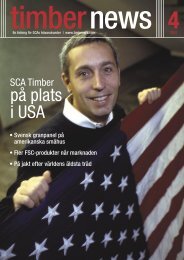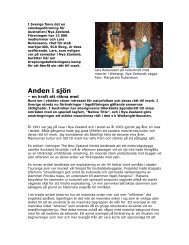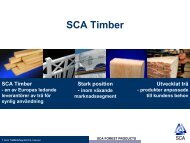TimberNews 4.02-engelsk - SCA Forest Products AB
TimberNews 4.02-engelsk - SCA Forest Products AB
TimberNews 4.02-engelsk - SCA Forest Products AB
Create successful ePaper yourself
Turn your PDF publications into a flip-book with our unique Google optimized e-Paper software.
Swedes still standingin FranceThey are known as ‘the Swedes’: 400 timber housesthat came as a gift from heaven to a battered Normandyafter the end of World War II; 11,200 cubicmetres of Swedish timber that built peace, andchanged opinions about housing.Christmas and New Year 1945,more than a year after D-Dayand the most comprehensiveamphibious landing operationin history. Normandy was free ...but in ruins. The Allied bombardmenthad flattened almost everyhouse in and around the Frenchcity of Caen. The people wereliving in hovels.Victor Vinde, a Swedish journalist,wrote a series of articlesabout the wretched conditions ofthe population. His reports shookSweden. Save the Children, theSwedish timber industry andSwedish carpenters joined forcesto help the needy. Prince Bertil ledthe aid initiative, the evidence ofwhich is still visible in Normandyto this day. Boat after boat sailedfrom Sweden carrying 400 semifabricatedhomes, nurseries andeven a church to Caen.Jacques Munerel wasjust one year old whenhe moved into thehouse where he stilllives, half a centurylater. His parents toldhim how the timberhouses were received:“People were sceptical about thetimber houses. Living in timberhouses was, at best, somethingreserved for monkeys. But whenthe houses were finished, peoplequickly saw that they were reallyluxurious – du Grand Luxe,” relatesJacques Munerel.The timber houses had WCs,bathrooms and washing rooms.In France, Caen has always beenJacques Munerel and his partner Carol Pitrou, rue de Suède.famous for its special limestone,which is called la pierre de Caen.However, the locals soon realisedthat the Swedish timber hadremarkable properties as regardsdurability and insulation. In addition,they were amazed at thespeed with which the Swedishconstruction workers built thehouses.To complete the picture, theSwedish workers even plantedspruce trees alongside the broadstreets in the different residentialareas. To this day, the streets havenames such as rue de Suède, rue deSandviken and rue de Kiruna. Thewarmth and gratitude still remain,one and even two generations later.Jacques Mourier, 47, who liveson rue de Stockholm, principallyappreciates the flexibility of ‘theSwedes’.“When I took over my parents’house, I wanted to make somemajor changes, and it was simpleas anything to move the timberwalls. When they come to visit,my friends gape in amazement,”he says proudly. Jacques Mouriersays that his children are now bigenough to get married and buildtheir own houses. And guess whatmaterial they are using …Magnus FalkehedPhoto: Magnus Falkehed
















